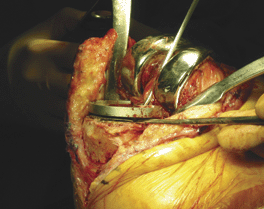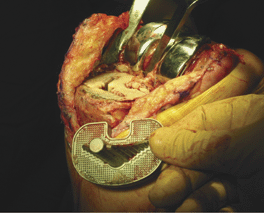Reporting knee revision surgery correctly
Author: Margaret M. Maley, BSN, MS
Category: Practice Management
Date: Sep 2007
Reporting knee revision surgery does not need to be complicated or mysterious. It does require an understanding of both the definition of revision surgery and the modifier 58.
A single-stage procedure
When a total knee prosthesis is removed and replaced as the definitive procedure during the same operative session, it is considered knee revision surgery. This is reported using current procedural terminology (CPT) code 27487—Revision of total knee arthroplasty, with or without allograft; femoral and entire tibial component.
A 2-stage procedure
What happens when the surgery is not so straightforward and the procedure has to be done in stages? Assume a situation in which the surgeon removes a knee prosthesis and inserts cement or a prosthetic spacer at the time the implant is removed. If this procedure is performed outside the global period of the original surgery, it would be reported using code 27488—Removal of prosthesis, including total knee prosthesis, methylmethacrylate with or without insertion of spacer, knee.
Six weeks later, the same surgeon brings the patient back to the operating room to remove the spacer and replace it with the definitive knee prosthesis. This procedure would be reported using code 27447-58, 22—Arthroplasty, knee, condyle and plateau; medial AND lateral compartments with or without patella resurfacing (total knee arthroplasty).
Reporting either of these surgeries with the revision code 27487 would be incorrect because the CPT code that describes total knee revision surgery requires that the exchange to the definitive prosthesis be done in the same surgical session.
Using modifiers
Modifier 58 is attached to a staged or related procedure performed in the postoperative or global period of the original surgery. The modifier is appended to the CPT code for the subsequent procedure to indicate that the subsequent procedure was (1) planned prospectively at the time of the original procedure (staged) or (2) subsequent surgery that was more extensive than the original procedure or (3) for therapy following a diagnostic surgical procedure.
Medicare assigned a 90-day global period to CPT code 27488. Any planned or staged surgery done within 90 days would require the use of modifier 58.
Modifier 22 describes “unusual procedural services” and is appended to the second stage of the knee reconstruction. Code 27447 (Arthroplasty, knee, condyle and plateau; medial AND lateral compartments with or without patella resurfacing [total knee arthroplasty]) does not describe inserting the prosthesis through the altered surgical field, which may have been previously infected or scarred. Because the surgical field has been altered, the procedure is more difficult and the use of modifier 22 is justified.
Reporting with a spacer
If the spacer inserted during the first stage of a 2-stage knee revision procedure is made of nonbiodegradable antibiotic-impregnated cement, it must also be reported, as follows:
Stage 1:
- 27488—Removal of prosthesis, including total knee prosthesis, methylmethacrylate with or without insertion of spacer, knee.
- 11981-58, 51—Insertion, non-biodegradable drug delivery implant
Stage 2:
- 27447-58, 22—Arthroplasty, knee, condyle and plateau; medial AND lateral compartments with or without patella resurfacing (total knee arthroplasty)
- 11982-58, 51—Removal, non-biodegradable drug delivery implant
The cement spacer insertion and removal is reportable using the codes for the nonbiodegradable drug delivery implant. Modifier 51 is appended to indicate that multiple procedures were done by the same provider at the same session. This modifier is always appended to the lesser procedure and reimbursement for multiple procedures is reduced.
Remember this
When reporting knee revision surgery, remember the following four guidelines:
- Use a revision code only if the prosthesis is removed and the definitive one inserted in the same operative session.
- Report the insertion and removal of nonbiodegradable antibiotic impregnated cement spacers separately. If the spacer is not impregnated with nonbiodegradable antibiotics, its insertion and removal is included in the primary code.
- You must use modifier 58 if the second stage is performed during the global period of the initial surgery.
- Do not use modifier 58 to indicate the treatment of a complication.
Understanding these guidelines can help ensure that coding is not the most complicated part of knee revision surgery.
Margaret M. Maley is a consultant with KarenZupko & Associates. For more advice on CPT and diagnosis coding, visit the KarenZupko & Associates Web site, www.karenzupko.com, select the orthopaedic community, and see the “Orthopaedic Coding Coach.”

